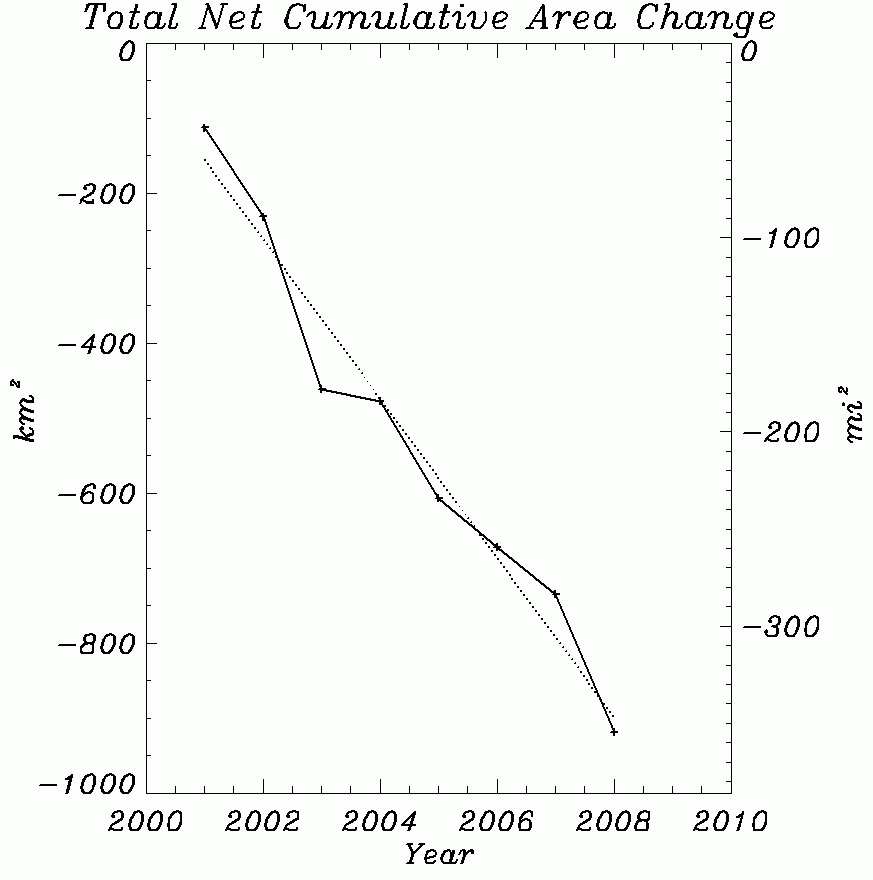The AP reports on new data to be presented at the annual meeting of the American Geophysical Union:
More than 2 trillion tons of land ice in Greenland, Antarctica and Alaska have melted since 2003, according to new NASA satellite data that show the latest signs of what scientists say is global warming.
More than half of the loss of landlocked ice in the past five years has occurred in Greenland, based on measurements of ice weight by NASA’s GRACE satellite, said NASA geophysicist Scott Luthcke. The water melting from Greenland in the past five years would fill up about 11 Chesapeake Bays, he said, and the Greenland melt seems to be accelerating.
This staggering ice loss is all the more worrisome because it was not predicted by the IPCC’s climate models. As Penn State climatologist Richard Alley said in March 2006, the ice sheets appear to be shrinking “100 years ahead of schedule.” In 2001, the IPCC thought that neither Greenland nor Antarctica would lose significant mass by 2100. They both already have.
Even the 2007 IPCC report assumed very little contribution to sea-level rise this century from Greenland and Antarctica, since it was based almost exclusively on studies done before 2006. And that’s of course why a U.S. Geological Survey study concluded sea-level rise in 2100 will likely “substantially exceed” IPCC projections. For the most credible post-IPCC study see here.
One reason landlocked ice is flowing faster: The floating ice shelves that normally block that ice like a cork in a bottle are disappearing at a staggering rate. Ohio State researchers reported at the AGU meeting this week that “the amount of ice lost this summer is nearly three times what was lost one year ago“:

The loss of floating ice in 2008 pouring from Greenland’s glaciers would cover an area twice the size of Manhattan Island in the U.S., they said.
Jason Box, an associate professor of geography at Ohio State, said that the loss of ice since the year 2000 is 355.4 square miles (920.5 square kilometers), or more than 10 times the size of Manhattan.
“We now know that the climate doesn’t have to warm any more for Greenland to continue losing ice,” Box said. “It has probably passed the point where it could maintain the mass of ice that we remember.
The accelerated loss of sea ice should come as no surprise given that another study presented at the AGU meeting found accelerated Arctic warming:
… parts of the Arctic north of Alaska were 9 to 10 degrees warmer this past fall, a strong early indication of what researchers call the Arctic amplification effect. That’s when the Arctic warms faster than predicted, and warming there is accelerating faster than elsewhere on the globe.
As sea ice melts, the Arctic waters absorb more heat in the summer, having lost the reflective powers of vast packs of white ice. That absorbed heat is released into the air in the fall. That has led to autumn temperatures in the last several years that are six to 10 degrees warmer than they were in the 1980s.
And that has led to the rapid sea-ice loss:
Using daily images from instruments called MODIS (Moderate Resolution Imaging Spectroradiometer) aboard two of NASA’s satellites, Box and his team are able to monitor changes in 32 of the largest glaciers along Greenland’s coast.They determined that during the summer of 2006-2007, the floating ice shelves at the seaward end of those glaciers had diminished by 24.29 square miles (62.9 square kilometers). But one year later — the summer of 2007-2008 — the ice loss had nearly tripled to nearly 71 square miles (183.8 square kilometers). Much of this additional loss is from a single large floating ice tongue called the Petermann Glacier.
Late this summer, the Ohio State researchers were able to watch as a massive 11-square-mile (29-square kilometer) chunk broke off from the tongue of the massive Petermann Glacier in Northern Greenland. At the time, they also noted that a massive crack further up the ice shelf suggested an even larger piece of ice would soon crack off.
Again, losing floating ice doesn’t directly raise sea levels, but it does open the floodgates for land ice to stream out faster, which is precisely what is happening.
In the 1990s, Greenland didn’t add to world sea level rise; now that island is adding about half a millimeter of sea level rise a year, NASA ice scientist Jay Zwally said in a telephone interview from the conference.
Between Greenland, Antarctica and Alaska, melting land ice has raised global sea levels about one-fifth of an inch in the past five years, Luthcke said. Sea levels also rise from water expanding as it warms.
And still I get people commenting here that the earth can’t be warming because, hey, it’s cold outside or because the most credible scientific organizations in the world occasionally make inconsequential mistakes that they quickly correct!
This post was created for ClimateProgress.org, a project of the Center for American Progress Action Fund.

